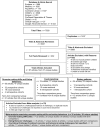Eating Behaviors, Caregiver Feeding Interactions, and Dietary Patterns of Children Born Preterm: A Systematic Review and Meta-Analysis
- PMID: 35157009
- PMCID: PMC9156386
- DOI: 10.1093/advances/nmac017
Eating Behaviors, Caregiver Feeding Interactions, and Dietary Patterns of Children Born Preterm: A Systematic Review and Meta-Analysis
Abstract
Infants born preterm (<37 weeks of gestation) often experience feeding problems during hospitalization. Whether difficulties persist or have long-term sequelae on childhood eating is unclear. We aimed to describe the oromotor eating skills (e.g., chewing/swallowing), eating behaviors (e.g., food neophobia), food parenting practices (e.g., pressure to eat), and dietary patterns of preterm children during late infancy (6-12 mo) and early childhood (>12 mo-7 y) and to determine whether these differed from those of term-born peers. We identified 67 articles (57 unique studies) for inclusion. We used random-effects meta-analysis of proportions to examine the prevalence of oromotor eating skill and eating behavior challenges among preterm children, standard meta-analysis for comparisons with term-born peers, and the Grading of Recommendations, Assessment, Development and Evaluation approach to assess the certainty of evidence. Forty-three percent (95% CI: 24%, 62%) of infants and 25% (95% CI: 17%, 33%) of children born preterm experienced oromotor eating difficulties and 16% (95% CI: 4%, 27%) and 20% (95% CI: 11%, 28%), respectively, exhibited challenging eating behaviors. During late infancy and early childhood, oromotor eating difficulties (OR: 2.86; 95% CI: 1.71, 4.77; I2 = 67.8%) and challenging eating behaviors (OR: 1.52; 95% CI: 1.11, 2.10; I2 = 0.0%) were more common in those born preterm than in those born term: however, the certainty of evidence was very low. Owing to the low number and heterogeneity of studies, we narratively reviewed literature on food parenting and dietary patterns. Mothers of preterm infants appeared to have heightened anxiety while feeding and utilized coercive food parenting practices; their infants reportedly received less human milk, started solid foods earlier, and had poorer diet quality than term-born peers. In conclusion, meta-analyses show preterm children experience frequent oromotor eating difficulties and challenging eating behaviors throughout the early years. Given preterm birth increases risk of later obesity and diet-related chronic disease, research examining the effects of caregiver-child interactions on subsequent diet is warranted. This review was registered at www.crd.york.ac.uk/prospero/ as CRD42020176063.
Keywords: diet quality; eating behaviors; feeding and eating disorders of childhood; feeding skills; food parenting; meta-analysis; oromotor skills; parent–child interaction; picky eating; preterm birth.
© The Author(s) 2022. Published by Oxford University Press on behalf of the American Society for Nutrition.
Figures







References
-
- Ross ES, Browne JV. Feeding outcomes in preterm infants after discharge from the neonatal intensive care unit (NICU): a systematic review. Newborn Infant Nurs Rev. 2013;13(2):87–93.
-
- Browne JV, Ross ES. Eating as a neurodevelopmental process for high-risk newborns. Clin Perinatol. 2011;38(4):731–43. - PubMed
-
- Silberstein D, Geva R, Feldman R, Gardner JM, Karmel BZ, Rozen H, Kuint J. The transition to oral feeding in low-risk premature infants: relation to infant neurobehavioral functioning and mother–infant feeding interaction. Early Hum Dev. 2009;85(3):157–62. - PubMed
-
- Sanchez K, Boyce JO, Morgan AT, Spittle AJ. Feeding behavior in three-year-old children born <30 weeks and term-born peers. Appetite. 2018;130:117–22. - PubMed

